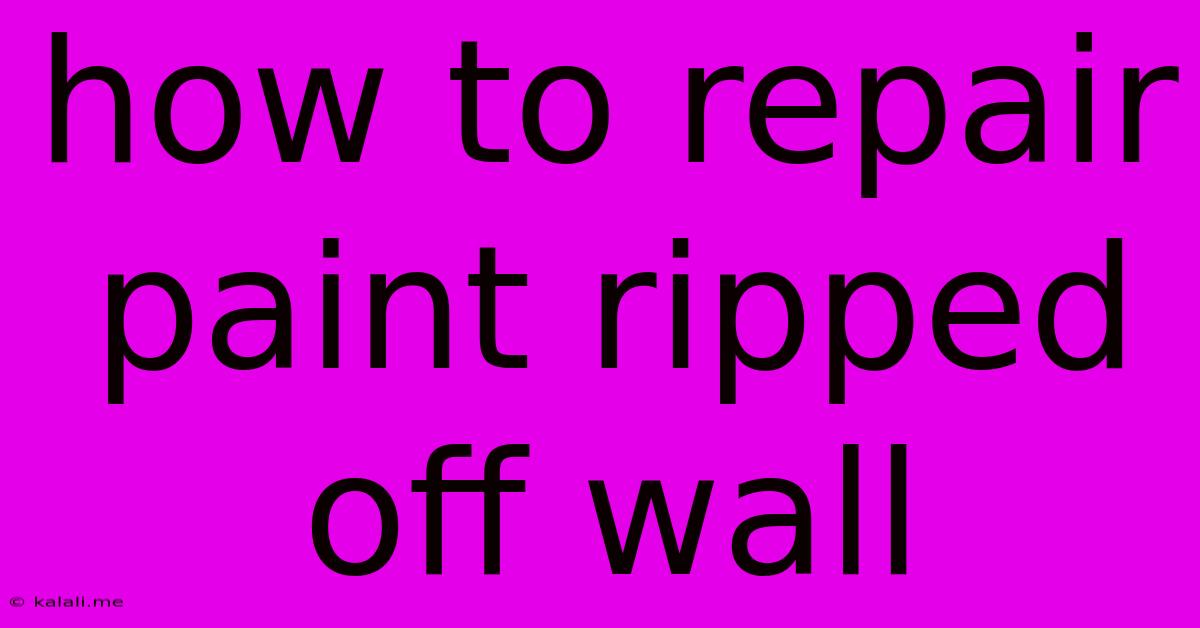How To Repair Paint Ripped Off Wall
Kalali
May 29, 2025 · 4 min read

Table of Contents
How to Repair Paint Ripped Off a Wall: A Step-by-Step Guide
Meta Description: Dealing with a section of paint ripped from your wall? Don't panic! This comprehensive guide provides a step-by-step solution to repair the damage, restoring your walls to their former glory. Learn about patching, priming, and painting techniques for a seamless finish.
Ripped paint on your wall can be unsightly and frustrating. Whether it's a small tear or a larger section missing, repairing the damage doesn't have to be a daunting task. With the right tools and techniques, you can achieve a professional-looking repair that blends seamlessly with the existing wall. This guide provides a comprehensive walkthrough of how to repair paint ripped off a wall, covering everything from preparing the area to the final coat of paint.
1. Assessing the Damage and Gathering Supplies
Before you begin, it's crucial to assess the extent of the damage. A small tear requires a different approach than a larger section of missing paint and possibly drywall. For larger areas, you may need to repair the underlying drywall before addressing the paint.
Supplies You'll Need:
- Putty knife: For scraping loose paint and applying patching compound.
- Sandpaper: Various grits (e.g., 120, 220) for smoothing surfaces.
- Patching compound (or drywall compound): For filling larger holes or damaged areas. Choose a lightweight compound for easier application.
- Primer: To ensure proper adhesion of the new paint and to cover any discoloration.
- Paint: Matching the existing wall paint as closely as possible.
- Paint roller and brush: For even application of primer and paint.
- Painter's tape: To protect surrounding areas.
- Drop cloth or plastic sheeting: To protect your floor.
- Sponges or damp cloths: For cleaning up.
- Safety glasses and dust mask: For protection during sanding.
2. Preparing the Damaged Area
This step involves cleaning and preparing the surface for repair.
- Clean the area: Remove any loose debris, dust, or dirt using a brush or damp cloth.
- Scrape away loose paint: Use a putty knife to carefully scrape away any loose or flaking paint around the damaged area. Ensure the edges are clean and smooth. Be gentle to avoid causing further damage to the wall.
- Sand the area: Once the loose paint is removed, lightly sand the edges of the damaged area to create a smooth transition for the patching compound. This helps the patch adhere better.
3. Patching and Filling the Damaged Area
The patching method depends on the size and nature of the damage.
- Small tears: For minor tears or chips, a small amount of patching compound may suffice. Apply it with a putty knife, smoothing it down to be flush with the surrounding wall. Let it dry completely according to the manufacturer's instructions.
- Larger holes or damaged areas: For larger holes or significant damage, you may need to apply several thin layers of patching compound, allowing each layer to dry before applying the next. This prevents cracking and ensures a smooth finish. For larger holes, consider using a drywall mesh tape embedded within the compound to provide extra strength and prevent cracking.
4. Sanding and Priming
Once the patching compound is completely dry, sand the repaired area smooth using fine-grit sandpaper (e.g., 220). Wipe away any dust with a damp cloth. This ensures a smooth surface for the primer and paint to adhere to.
Apply a coat of primer to the repaired area. Primer helps to seal the patch, preventing the paint from bleeding through and ensuring good adhesion. Allow the primer to dry completely.
5. Painting and Finishing
Once the primer is dry, apply a coat of paint that matches your existing wall color. Use a small brush for detailed work around the edges of the repair, and a roller for larger areas. Let the paint dry completely. Apply a second coat if necessary for full coverage and a consistent finish.
6. Cleaning Up
After the paint has dried, remove any painter's tape and clean up any leftover materials. Your wall repair should now be seamless and undetectable!
By following these steps, you can successfully repair ripped paint on your wall and restore its appearance. Remember to always prioritize safety by wearing appropriate protective gear. With a little patience and attention to detail, you can achieve a professional-looking finish.
Latest Posts
Latest Posts
-
Can I Set Date Published As Updated When Citing
May 30, 2025
-
What Should My Coolant Temp Be
May 30, 2025
-
How To Keep Spiders Out Of Your Home
May 30, 2025
-
Ipod Nano 3g Not Showing Album Art
May 30, 2025
-
What Is The Last Name Of Jesus
May 30, 2025
Related Post
Thank you for visiting our website which covers about How To Repair Paint Ripped Off Wall . We hope the information provided has been useful to you. Feel free to contact us if you have any questions or need further assistance. See you next time and don't miss to bookmark.